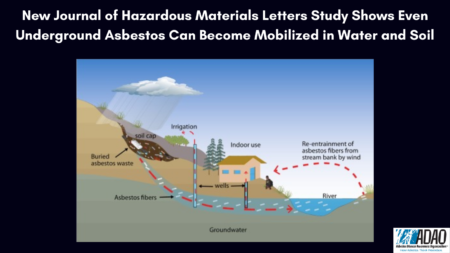Posted on July 21, 2021
 A new study published by the Journal of Hazardous Materials Letters disproved the longstanding assumption that asbestos fibers are immobile in soils and cannot move in groundwater no matter the condition. The study instead proves that mobility of asbestos fibers below ground is instead enhanced by dissolved organic matter from soil amendments.
A new study published by the Journal of Hazardous Materials Letters disproved the longstanding assumption that asbestos fibers are immobile in soils and cannot move in groundwater no matter the condition. The study instead proves that mobility of asbestos fibers below ground is instead enhanced by dissolved organic matter from soil amendments.
Millions of people live near contaminated asbestos sites. To protect these people, the sites are usually covered with soil and amendments due to the belief that asbestos mobility underground is not possible regardless of the conditions. However, this new study shows that these people could be in danger of asbestos exposure since asbestos fibers are in fact mobile underground. Asbestos kills over40,000 people in the U.S. each year, yet hundreds of tons are still imported and used annually.
According to the authors of the new study, the “results disproved the prevailing assumption that asbestos fibers are immobile in soils and could not move in groundwater in all conditions. We showed that exposure to certain types of DOM at the contaminated sites can increase asbestos mobility.”
These results “may have profound consequences on the asbestos mobility in soils and groundwater, which in turn could increase asbestos exposure to millions of people living near asbestos-contaminated sites.”
There are two major examples of sites where asbestos is found in the soil, water, and air: Ambler, PA, and Libby, MT. Today, areas surrounding the abandoned vermiculite processing and mining facilities, including much of the town of Libby, are contaminated with these asbestos fibers, contributing to an outbreak of asbestos-related diseases in the Libby population. Trees in Libby and in forested areas surrounding the abandoned mine have accumulated amphibole asbestos fibers on their bark surface, causing asbestos exposure through inhalation Several studies have been conducted to further understand this exposure pathway.
It is not just our air, soil, and water we need to worry about. The U.S. Environmental Protection Agency (EPA) estimates that up to 35 million homes, schools, and office buildings contain asbestos materials. Beginning in the 1960s and continuing into the 1980s, cities throughout the U.S. installed millions of miles of asbestos-cement pipes. As these pipes wear over time, they rupture and require repair. In 2012, workers in Texas were exposed to asbestos while working on a water line. The Scientific Analytical Institute (SAI) determined that the pipe was composed of 35% asbestos (25% chrysotile asbestos and 10% crocidolite asbestos). A similar situation occurred in New York City. In 2018, a pipe burst in NYC and put almost 600 New York residents and first-responders in danger of asbestos exposure.
Asbestos exposure frequently affects our first responders and firefighters at higher rates than other citizens. As we learned during hurricanes Katrina, Sandy, and other natural disasters, asbestos exposure is highly likely during the clean-up and rebuilding process.
With studies like these and the growing pile of scientific evidence, we are learning more each year about how dangerous asbestos is to our nation’s citizens. That’s why we need strong legal and legislative strategies to rid the country of this man-made disaster once and for all. We have known for decades that asbestos is a carcinogen that causes fatal illnesses such as mesothelioma and cancers of the lung, larynx, and ovaries. But time and time again, our government and EPA failed to ban this toxin.
The Asbestos Disease Awareness Organization (ADAO) strongly supports the Alan Reinstein Ban Asbestos Now (ARBAN) Act of 2021, which will ban asbestos, provide Americans with the right to know where asbestos is imported and used and will force EPA to do a legacy study on all buildings in the U.S.
It is time to protect the health and well-being of all Americans. It is time to ban asbestos.
